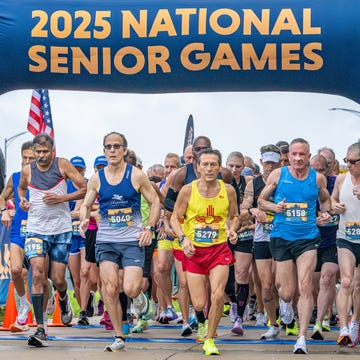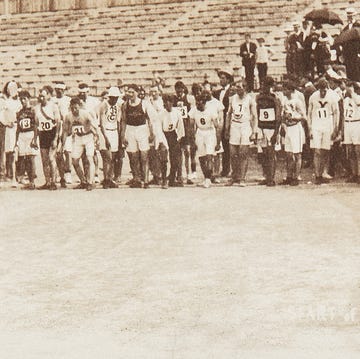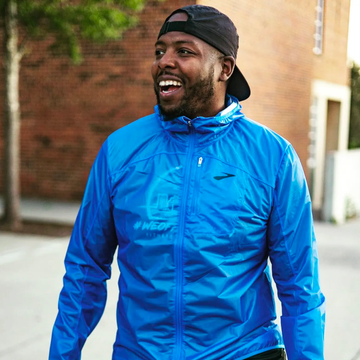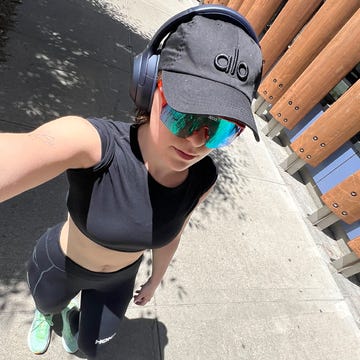Somewhere amongst the sprawling vineyards of Sonoma County, California sits a building that contains more than 4,000 artifacts spanning three centuries of track and field. Real estate broker (and Runner’s World+ member) Mike Fanelli, the keeper of the collection, has spent over 50 years preserving and celebrating the sport he loves, and it’s in this unassuming structure on his property—a place he affectionately calls “The Track and Field Garage”—where some of running’s most indelible moments live on.
The very first item in Fanelli’s vault was a program from the 1969 AAU Indoor National Championships in Philadelphia, where Fanelli grew up. As a 12-year-old, Fanelli snagged autographs from the American stars who earned gold medals in the previous year’s Mexico City Summer Olympics, including Madeline Manning Mims (800 meters) and George Young (3,000-meter steeplechase). “I ran after anyone who had that blue uniform with the big ‘U.S.A.’ on it, trimmed in red,” he says.
Though Fanelli, 65, started collecting his treasures in 1969, some items date back much further. He owns the program from the U.S.’s first indoor track meet, held at a New York City skating rink in 1868. He also has every issue of Track and Field News (founded in 1948) and Distance Running News (1966), which later became Runner’s World.
To build the foundation of his collection, Fanelli browsed flea markets, used booksellers, and antique dealers, but now only scores items that contribute to his ultimate goal: to create the definitive library of the entire history of track and field. His elusive Holy Grail? The program from the legendary 1935 Big Ten Track and Field Championships, where sprinter Jesse Owens broke three world records and tied a fourth in a staggering 45-minute window.
But Fanelli isn’t just a dedicated curator—he’s a track and field enthusiast in every sense of the word. “I’ve worn an awful lot of hats in this sport,” he says. As an agent, he’s negotiated contracts and footwear deals for international track and field athletes. He was the USATF National Cross Country chairman from 1992 to 1994 and coached the U.S. national team at international distance events in 1992, 1996, and 2000. Plus, he led the Impala Racing Team—an all-women’s elite development team in San Francisco—throughout the 1990s, guiding over a dozen athletes to the Olympic Trials.
Join Runner's World+ for unlimited access to the best training tips for runners
As you’d expect, Fanelli meticulously catalogues his own miles. Since 1970, he’s jotted down every single run—113,500 miles and counting—in a variety of composition notebooks. “There are two things in this sport that will keep you honest: the track and your training log,” he says. “They don’t lie—they tell you exactly where you’re at. Now, not everybody wants to know exactly where they’re at. But I do.”
Fanelli recalls the dates of significant events with encyclopedic precision. For example, he logged his 100,000th mile on November 17, 2012; knows he missed overlapping with Steve Prefontaine in Eugene, Oregon exactly two weeks before Pre’s untimely death on May 30, 1975; and met his wife, Renay, on April 15, 1996—the 100th annual Boston Marathon.
Fanelli is looking forward to the 2026 World Masters Athletics Championships, where he hopes to compete as a 70-year-old in the 800 meters (his favorite event) and 10,000 meters (in which he’s held the San Francisco State University record since 1981). But beyond achieving personal running goals, he simply strives to keep track and field alive.
That starts with maintaining his collection—which he will someday donate to an academic institution—but also sharing daily historical anecdotes and photos with his thousands of Facebook friends, including running nerds, college coaches, and even Olympians.
So much of track and field history is either poorly recorded or unavailable online, Fanelli says, so he and his friends eagerly fill in the gaps. “I refer to it as ‘cultural storytelling.’ When a particular culture wants to pass down their history over the years, and it’s not something that can be transcribed otherwise, this is our opportunity to do that.”
🎥 Now Watch This:
Theo Kahler is the news editor at Runner’s World. He’s a former all-conference collegiate runner at Winthrop University, and he received his master’s degree in liberal arts studies from Wake Forest University, where he was a member of one of the top distance-running teams in the NCAA. Kahler has reported on the ground at major events such as the Paris Olympics, U.S. Olympic Trials, New York City Marathon, and Boston Marathon. He’s run 14:20 in the 5K, 1:05:36 in the half marathon, and enjoys spotting tracks from the sky on airplanes. (Look for colorful ovals around football fields.)

















